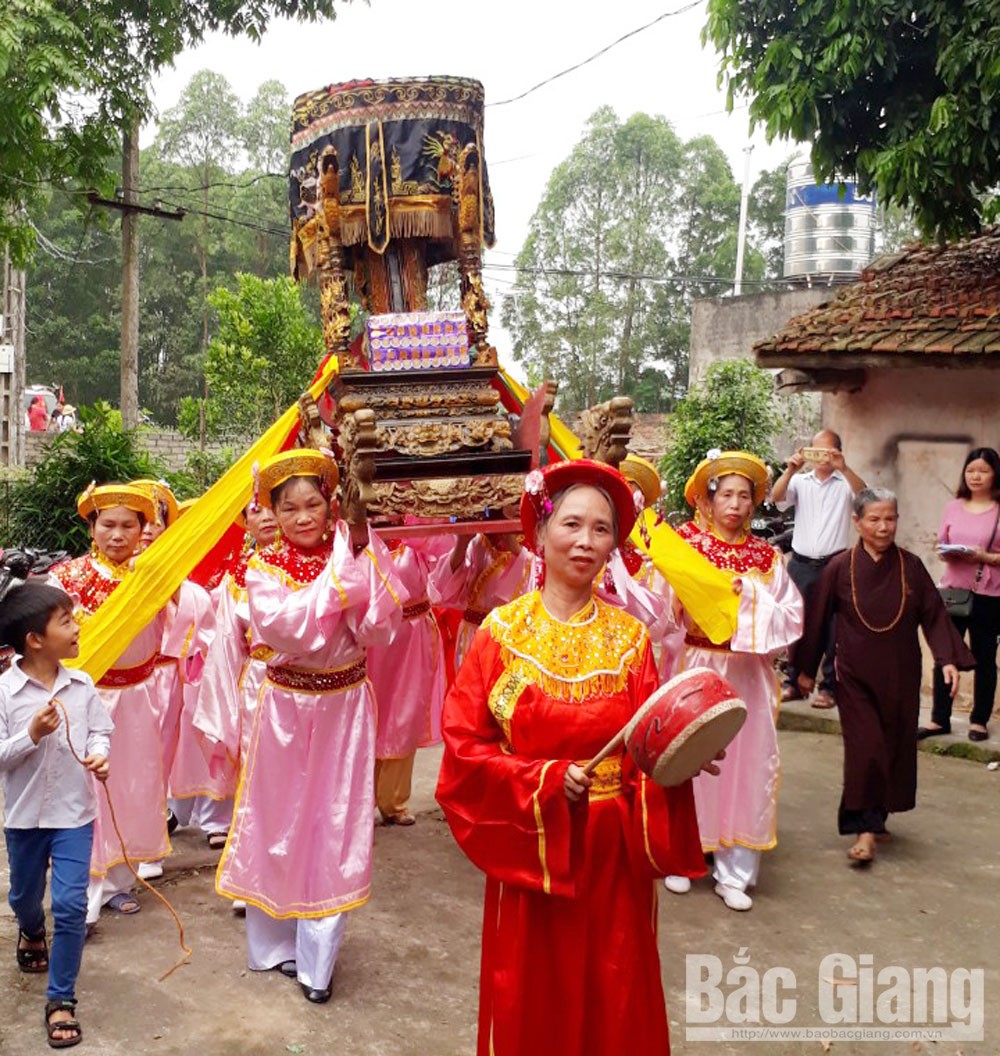Unique folk festival of Dot Mountain area
Dot Mountain, located in the northwestern part of Tan Yen district at a height of 121.8m, is the highest point in the district and also the boundary between the two provinces of Bac Giang and Thai Nguyen. It also preserves many valuable cultural heritages, including the folk festival of the Dot Mountain area, which relates to the belief of worshipping Lady Gia, a high-ranking mandarin.
 |
|
View of the procession in the folk festival of Dot Mountain area. |
The Ly Cot relic complex, including a communal house, a pagoda, a shrine, a grave, Ha well and Dot temple in Phuc Son commune (Tan Yen), is the place keeping the images of Lady Gia, or Duong Thi Gia, a female general of the Trung Sisters, who had a merit to defeat the invading Han troops.
This complex is located on the hills of Dinh Forest and Dot Mountain. The Ly Cot communal house, pagoda and shrine follow the architectural model of the communal house in the front and the pagoda in the back. The complex’s campus still houses a multi-hundred-year ancient tree, which creates an ancient ecological beauty for the complex.
The work was built during Le Trung Hung period (17th – 18th centuries) and was repaired many times. Every year, the festival opens here on the 14th day of the first lunar month and the eighth day of the fourth lunar month. The festival has a unique nuance related to the worship of the goddess and associated with the history of the nation, perhaps only found in the Dot Mountain cultural area.
The local people have the sentence: "Tram, Luong, Ly Cot, Pham, Giang/ the eighth day of the fourth lunar month is the death anniversary of Lady Gia".
The worship of Lady Gia originates from the legend: In the time of the Trung Sisters’ struggle against the Han invaders (in 40 AD), Duong Thi Gia in the Dot Mountain area gathered patriots to stand up to fight the foreign invaders and safeguard the homeland. Her troops moved to Me Linh to join the Trung Sisters insurgent army. She was promoted to a female general and made many glorious victories.
There were times she let the troops return to Dot Mountain for a favorable opportunity to attack the enemy. The insurgents had to experience many difficulties and hardships. The people did not go to the fields to wait for the order to fight the enemy.
In a fierce battle, because of weak forces, her troops were defeated. Despite wounds full of her body, she alone rode a horse breaking the enemy's circle to go home. Arriving in Dot Mountain next to Ha well (Ly Cot, Phuc Son), she jumped into the well to kill herself. This area still houses the well and her grave.
To commemorate the merit of Lady Gia, the local people built a shrine to worship her and took the eighth day of the fourth lunar month, the anniversary of her death, as the village's traditional day. On this day, people in the area have the customs of “banning fire" and "banning going to the field".
On the seventh day, all preparations for Lady Gia’s death anniversary must be completed, and on the eighth day, no one is allowed to go to the field to work, and cooking is banned in every house. All families prepare offerings to worship the female general.
The offerings must be in black color such as black flag, black incense, black horse, black pig, black chicken and black sticky rice ... In these days, all families eat cold food like rice balls, round and square cakes. These are to remember the items and food used to feed the army of Lady Gia.
Relating to the belief of worshiping Lady Gia, there is also the communal house in Chuong village, Nha Nam township. Other legend says that Duong Thi Gia was born in Chuong village, Nha Nam, but was sacrificed in Dot Mountain so the communal houses, pagodas and shrines were built in both places to worship her.
These two localities have traditionally been twinned and helped each other in cases of misfortune and hardship. This custom has been passed from generation to generation. People in the area often say "Ly Cot communal house, Nha Nam pillars" to affirm the bond and solidarity between the two villages.
Every year, the two villages hold festivals on the eighth day of the fourth lunar month during which processions and worshipping ceremonies are held solemnly. During the festivals, folk games such as horse racing, wrestling, tug-of-war, cockfighting, chess, blind man's buff and Quan ho (love duet) singing... attract a large number of people in the area.
Dong Ngoc Duong
 Bắc giang
Bắc giang















Reader's comments (0)